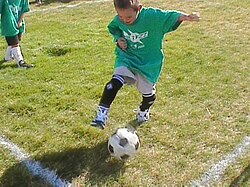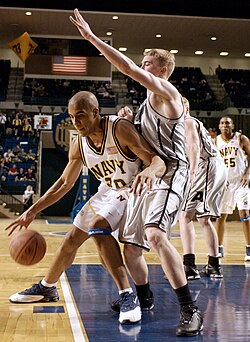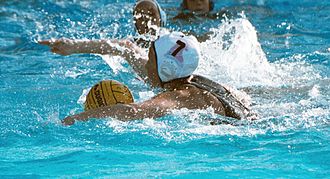Difference between revisions of "AY Honors/Basketball/Answer Key"
(outlined requirements) |
(I told a cool link to a basketball teams site.) |
||
| Line 1: | Line 1: | ||
| − | + | In [[sport]]s such as [[football (soccer)]], [[basketball]] and [[water polo]], '''dribbling''' refers to the maneuvering of a ball around a defender through short skillful taps or kicks with either the legs (football/soccer), hands (basketball) or swimming strokes (water polo). The purpose of such an action is to bring the ball past a defender legally and to create opportunities to score. | |
| − | + | ||
| − | + | ==Association football== | |
| − | == | + | [[Image:Kid playing soccer.jpg|thumb|220px|Young player dribbling]] |
| − | + | In [[association football]] (soccer), a dribble is one of the most difficult ball skills to master and one of the most useful attacking moves. In typical game play, players attempt to propel the ball toward their opponents' goal through individual control of the ball, such as by dribbling (running with the ball close to their feet). | |
| − | + | ||
| − | + | The ability to dribble is often invaluable especially in the third part of a pitch or at the wings, where most attacks take place. Dribbling creates space in tight situations where the dribbler is marked (closely guarded by a defender), and the dribbler can either create scoring chances or score him- or herself after a successful dribble. However, dribbling, if poorly mastered and used, may result in the loss of possession either when the ball is intercepted or [[Tackle (football move)|tackle]]d by a [[Defender (football)|defender]]. When used appropriately, a good dribbler is often hard to dispossess; unsuccessful tackles (which does not reach the ball) may result in a useful [[free kick]] situation, a [[yellow card]] for the offender, or both. | |
| − | + | ||
| − | + | ==Basketball== | |
| − | + | [[Image:Basketball game.jpg|thumb|right|210px|U.S. Naval Academy ("Navy") player, left, attempts to dribble past U.S. Military Academy ("Army") defender]] | |
| − | + | In [[Basketball#Dribbling|basketball]], dribbling is the legal method of advancing the ball by oneself, as opposed to passing it to another player or shooting for the basket. It consists of bouncing the ball on the floor continuously while walking or running down the court. | |
| − | + | ||
| − | + | For a look at a successful basketball team go to www.leaguelineup.com/upstateballers2k7 | |
| − | + | ||
| − | + | The original Naismith rules said nothing about dribbling, merely stating that passing the ball was the legal way of advancing it. Players soon developed the strategy of "passing to themselves", which [[James Naismith]] himself both endorsed and admired for its ingenuity, and which evolved into the dribble as it is known today. | |
| − | + | ||
| − | + | The dribble allows for much faster advancement and thus more opportunities for scoring. It also provides an opportunity for a crafty player on the opposing team to "steal" the ball in mid-bounce. Once a player stops dribbling the ball and holds it, the player normally must either pass it to another player or take a shot; if the player dribbles and then holds the ball in any way (either grasping it with his hands or arms, or "palming" it, i.e. holding it too much toward its underside during the act of dribbling), then the referee stops the play, signals either "double dribble" or "carrying", and turns the ball over to the other team. | |
| − | + | ||
| − | + | Skilled ball handlers bounce the ball low to the ground, reducing the risk of a defender reaching in to steal the ball. Adept dribblers can dribble behind their backs, between their legs and change hands without watching the ball, making the player difficult to defend and opening up options to pass, shoot or drive with the ball. | |
| − | + | ||
| − | + | The [[National Association of Basketball Coaches]] (NABC) was founded in 1927 to oppose a move to eliminate dribbling from the sport. | |
| − | + | ||
| − | ; | + | ==Water polo== |
| − | + | [[Image:waterpolodribble.jpg|thumb|300px|Attacker (7) advances the ball by '''dribbling''']] | |
| − | + | In [[water polo]], dribbling is the technique of moving the ball while swimming forward, propelled ahead of the player with the [[wake]] created by alternating armstrokes. Since ball contact is minimal, this creates advantage for the ball carrier advancing the ball; the defender may not make contact unless the attacker is touching the ball. | |
| − | + | ||
| − | + | ==See also== | |
| − | + | *[[Basketball#Dribbling|Basketball]] | |
| − | + | *[[Basketball moves]] | |
| − | + | *[[Glossary of Water Polo]] | |
| − | + | ||
| − | + | [[Category:Ball games]] | |
| − | + | [[Category:Basketball terminology]] | |
| − | + | [[Category:Team sports]] | |
| − | + | [[Category:Football (soccer) terminology]] | |
| − | + | [[Category:Water polo]] | |
| − | + | ||
| − | + | [[de:Dribbeln]] | |
| − | + | [[pl:Drybling]] | |
| − | + | [[ru:Дриблинг]] | |
| − | + | [[ja:ドリブル]] | |
| − | |||
| − | |||
| − | |||
| − | ; | ||
| − | |||
| − | |||
| − | |||
| − | |||
| − | |||
| − | |||
| − | |||
| − | |||
| − | |||
| − | |||
| − | |||
| − | == | ||
| − | |||
| − | |||
| − | == | ||
| − | |||
| − | |||
| − | |||
| − | |||
| − | |||
| − | |||
| − | |||
| − | |||
| − | [[ | ||
Revision as of 15:55, 11 December 2006
In sports such as football (soccer), basketball and water polo, dribbling refers to the maneuvering of a ball around a defender through short skillful taps or kicks with either the legs (football/soccer), hands (basketball) or swimming strokes (water polo). The purpose of such an action is to bring the ball past a defender legally and to create opportunities to score.
Association football
In association football (soccer), a dribble is one of the most difficult ball skills to master and one of the most useful attacking moves. In typical game play, players attempt to propel the ball toward their opponents' goal through individual control of the ball, such as by dribbling (running with the ball close to their feet).
The ability to dribble is often invaluable especially in the third part of a pitch or at the wings, where most attacks take place. Dribbling creates space in tight situations where the dribbler is marked (closely guarded by a defender), and the dribbler can either create scoring chances or score him- or herself after a successful dribble. However, dribbling, if poorly mastered and used, may result in the loss of possession either when the ball is intercepted or tackled by a defender. When used appropriately, a good dribbler is often hard to dispossess; unsuccessful tackles (which does not reach the ball) may result in a useful free kick situation, a yellow card for the offender, or both.
Basketball
In basketball, dribbling is the legal method of advancing the ball by oneself, as opposed to passing it to another player or shooting for the basket. It consists of bouncing the ball on the floor continuously while walking or running down the court.
For a look at a successful basketball team go to www.leaguelineup.com/upstateballers2k7
The original Naismith rules said nothing about dribbling, merely stating that passing the ball was the legal way of advancing it. Players soon developed the strategy of "passing to themselves", which James Naismith himself both endorsed and admired for its ingenuity, and which evolved into the dribble as it is known today.
The dribble allows for much faster advancement and thus more opportunities for scoring. It also provides an opportunity for a crafty player on the opposing team to "steal" the ball in mid-bounce. Once a player stops dribbling the ball and holds it, the player normally must either pass it to another player or take a shot; if the player dribbles and then holds the ball in any way (either grasping it with his hands or arms, or "palming" it, i.e. holding it too much toward its underside during the act of dribbling), then the referee stops the play, signals either "double dribble" or "carrying", and turns the ball over to the other team.
Skilled ball handlers bounce the ball low to the ground, reducing the risk of a defender reaching in to steal the ball. Adept dribblers can dribble behind their backs, between their legs and change hands without watching the ball, making the player difficult to defend and opening up options to pass, shoot or drive with the ball.
The National Association of Basketball Coaches (NABC) was founded in 1927 to oppose a move to eliminate dribbling from the sport.
Water polo
In water polo, dribbling is the technique of moving the ball while swimming forward, propelled ahead of the player with the wake created by alternating armstrokes. Since ball contact is minimal, this creates advantage for the ball carrier advancing the ball; the defender may not make contact unless the attacker is touching the ball.



